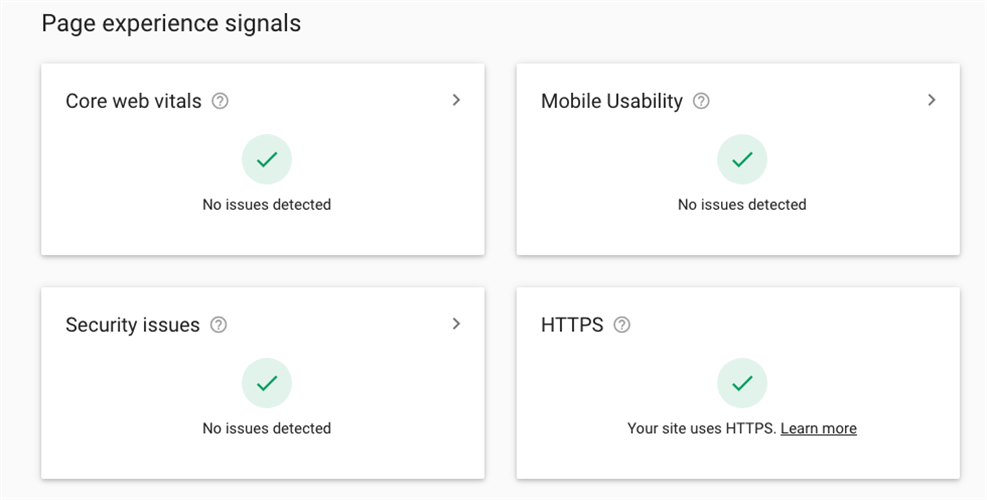Google core web vitals update
Written by Chris Monaghan
April 16th, 2021
Every now and then Google decides to shake things up, and how your website and web pages rank on their search engine results page change based on those changes. The Google core web vitals update is one of these changes and failing to address this is could cause your page traffic to decrease significantly.
There are a lot of other things in the SEO world that can cause your page traffic to drop but this article is aimed at how we at Small Market are dealing with this Google update to help ensure we can still drive organic traffic to our sellers product pages.
So what is this core web vitals update all about? Well, it's a set of rules that Google use in their algorithm to rank your page. The update mainly focuses around the website performance and user experience. This means Google is looking at how quickly your web pages load, how is the information is laid out, how a user interacts with your page, and one of the biggest checks is how mobile friendly your site is. The reason this is a big one is because Google runs these checks in mobile mode, which is why it's important that your website should be responsive and suitable for all devices and screen sizes – which we've worked hard at Small Market to achieve.
You might not be aware, but Small Market is a completely custom built platform. We don't use any off the shelf e-commerce platforms to create our marketplace, which gives us a huge advantage when it comes to implementing changes like these as we're in complete control of how Small Market is coded. This comes in handy when Google changes its algorithms and we need to make changes quickly, but also helps us to constantly improve the experience for buyers and sellers.
We give our sellers an SEO scanner for their product listings to give them the tools to get the best for each of their products, and we actively promote the use of these tools to ensure the site has as much favour with Google as we can muster! We're constantly evolving this to make sure we're as transparent as we can be with the changes and how they affect the way that the products will rank. But of course, a lot of it is on us and we're keen for Small Market as a site to cover off all of the major changes.
Google supplies you with tools to help measure your site to check for all the things it would like you to do. One of these tools is called 'Lighthouse' and they recently added more checks in the google webmaster console, which is where I spend a lot of my time, analysing and measuring our data, to help spot any issues that are occurring. This was the case when we were picked up by the last set of updates and our ranking dropped, so here are some things we put in place to resolve the core requirements that helps us bounce back up.
Here's my little boast - all of our hard-earned pass marks for site experience!

The core update has 3 main technical areas:
- LCP - Largest Content Paint
- FID - First Input Delay
- CLS - Cumulative Layout Shift
LCP, in simple terms, is when a page loads for the first time it goes to find the largest element in the visible screen area - this could be a image or text block - and it measures how long it takes to load so that it's visible to the end user. So on each product page you will find that the primary product image will be the LCP. To help improve how quickly that image loads we automatically optimise the images when our sellers upload them, reducing the size but keeping the quality. We do have future plans to improve this even more by replacing jpegs with the new WebP image format - so watch out for future blog posts about this - but so far this has allowed us to pass this metric requirement.
FID, this is really about first impressions of your site and how quickly a user can start interacting with your page. Google is measuring your web page loading speed and how well your front-end & back-end code has been written. After spending many hours ensuring the front-end code for Small Market was optimised using techniques like webpack for our Javascript files and lots of techniques for styles sheets, I was never particularly worried about this metric score.
CLS, this is all about how the elements on your page move about when loading up for the first time, and I've spent a lot time cracking this one. Product and seller pages have been cleaned up so nothings flickers when loading, and the loading orders are constantly being refined to give us the best output, which of course now gives us a great CLS score.
Working in the web industry really helps us to keep an eye on the changes that might occur within Google rankings, and gives us the ability to be able to resolve these with our platform, it helps to keep us on top ensuring we can please our sellers and push as much organic traffic to the site as we possibly can.